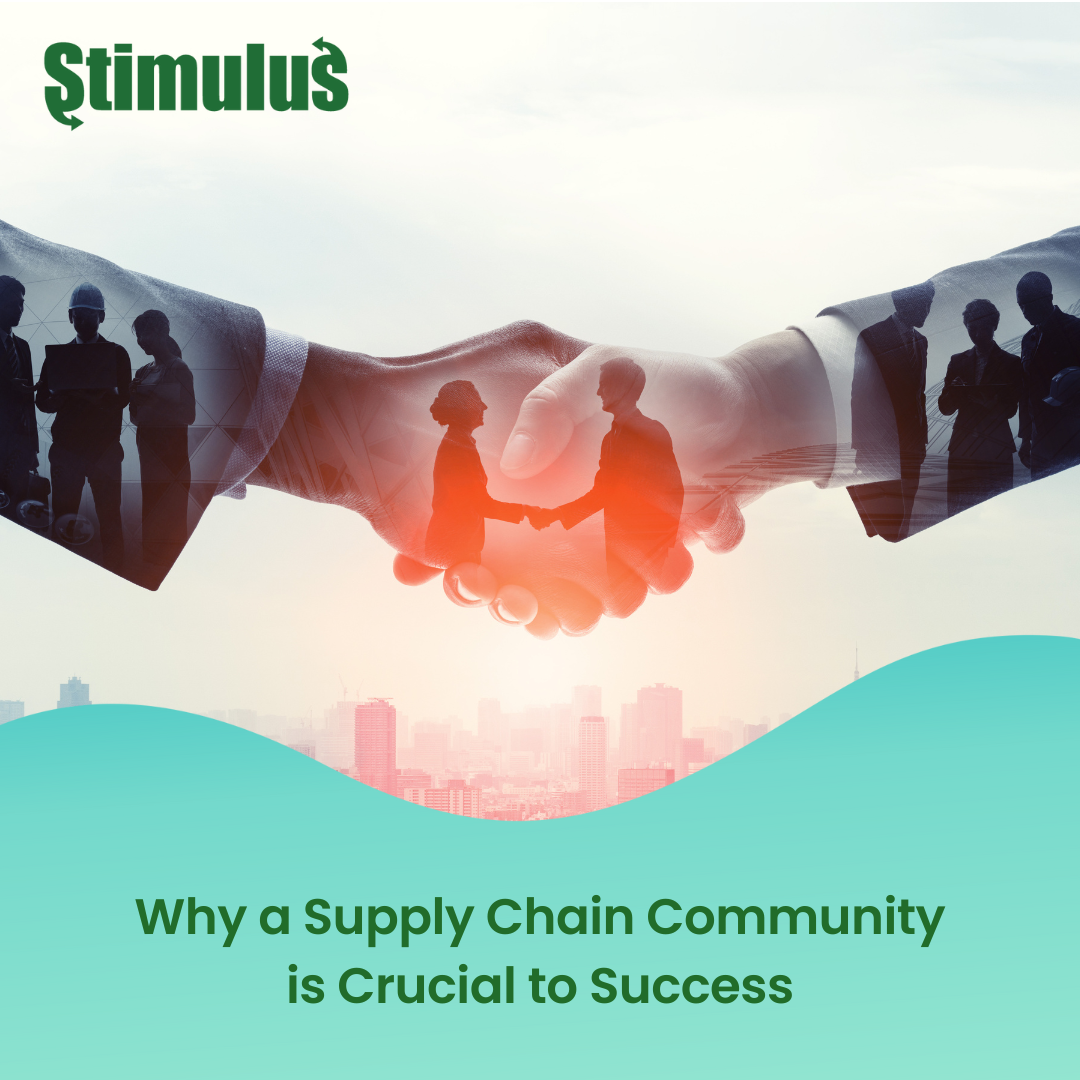Carla Monoy: Why the ‘Grass is Greener’ on the Stimulus Side

Peter Sondergaard, Senior Vice President and Global Head of Research at Gartner, Inc. once said, “Information is the oil of the 21st century, and analytics is the combustion engine.” In the world of supply chain management, data is the bread and butter that keeps every company thriving and growing despite disruptions and industry losses. This is why Stimulus has dedicated itself to working alongside the finest Data Analysts to create a platform that relies less on supplier size and more on their irrefutable and analytical reliability.
One of these hardworking Data Analysts is Carla Monoy, and her experience and unique approach has helped our customers to find reliable and suppliers across industries. Monoy works to generate actionable insights from data for companies to make better purchasing decisions. Her introduction to data science was in a previous role as academic researcher, where she examined vegetation datasets to understand the population dynamics of plant communities in the tropics. Carla admires the portable nature of data analysis, and is passionate about finding stories in numbers, using the tools of data science to gain insights into a wide variety of subjects. But, to truly understand how her background in biology and ecology has helped her ‘bloom’ a strong career in supply chain, we sat down with the ‘well-natured’ expert to learn more about her past, present, and future in data.
From Tropical Trees to Data Diversity
Carla Monoy began her career not in the supply chain market but rather in biology and plant studies. Although the industries may seem entirely different, Monoy claims they share more than you’d think in common, “My background is in biology and plant ecology so the work I did before, during, and after my undergrad and Master’s Degree was mostly academic research in the university and other research institutions. It involved doing long-term surveys and determining what species are found in particular forests and how they’re interacting with each other, surviving, and dying at various rates. A lot of this had to do with predictive data analysis and recognizing patterns which does correlate with what I do now to some degree.”
While Monoy admits that biology didn’t help her get a grip on the industry itself, the research and analytics skills were a major plus for her as she learned and determined patterns, “It’s quite a jump from biology to the work that I am doing at Stimulus, but I found that commonality of data analysis and patterns which helped me to use my experience to benefit our clients significantly. It was a bit of a steep learning curve for me in terms of the business side of supply chain and supplier diversity but, using my previous background to my benefit, I was able to find reputable sources and literature that helped me to find actual patterns in the market and determine trends accordingly.”
With a defined grip on the industry, Monoy believes it became far more clear how Stimulus stands apart from the rest in multiple positive ways. To explain how these insights defined her love for her new line of work and company, we chose to discuss Stimulus and its mission next.
Stimulus: A cut Above the Rest
Monoy transitioned from plants to business analytics and joined the Stimulus team in July of 2021. Her goal was to provide support to Stimulus and its mission by using data and analytics to help companies make better purchasing decisions. Now, she believes she is doing just that, “I enjoy working with Stimulus because I believe in the company and its mission. Our team has developed an amazing product which is constantly improving and iterating in order to support that mission. We have an excellent team and a great goal which really motivates me as a leader. I also feel we differ from others in the industry due to our focus on relationships between businesses and their suppliers. There is an advocacy side to our mission with the webinars, brand collaborations, and social media initiatives that helps make us a voice of authority and not just another name in the supply chain field.”
Although the Stimulus platform is still ever-changing and evolving, Monoy’s experience and dedication has helped shape it into the successful system that companies like Morgan Stanley and Northwestern Mutual are more than pleased to invest in and collaborate with. But, Monoy’s impact on the industry doesn’t end there as her pattern predictions may be the key to overcoming disruptions and increasing profits moving forward.
Analyzing the Market for Success as a Company Leader
While many analysts feel that saving money and working with bigger suppliers is the key to success, Monoy disagrees. Instead, as she stated when asked about analyzing the market as a leader, “I feel that it is crucial to get information from all sides: suppliers, stakeholders, and customers. The way we go about this is by studying other companies’ data and surveys to make educated guesses based on the patterns we find across the market. This is what I recommend for leaders of other companies as well if they want to have a better grip on the market for their own brands.
When we analyze data specifically for supplier analyses, we are compiling everything from previous business names, parent companies, and jurisdiction of incorporation all the way to their diversity in ownership, social media, and net profit. These are just a few of the analytics we measure as part of our Stimulus Relationship Intelligence Platform (SRIP) to help us connect the right companies with the best and most diverse suppliers in their area.
For my work specifically, we work with the customer-provided data our customers have acquired using their own collection methods. Then, we supplement that data with our own third-party open data sources to give them a more robust profile of the suppliers that they work with. Using that overview, we then provide our customers with other options for suppliers that they can work with that are in the same industry and possibly even the same location to diversify their supply chain.
For example, in healthcare, you tend to have larger vendors you’ve worked with for years and it’s really hard for these companies to shift to or explore other vendors. That’s something that we can help with in order to find reliable vendors without just relying on word-of-mouth or blind trust.”
Monoy also believes that reliability in data analytics is just as valuable for company leaders, “I’m also helping to build up our database to supplement the supplier data and ensure that our customers always get the most reliable and vetted data possible. For instance, if it’s a diverse company, what are their certifications and are they valid for this year? Also, who certified them? I would say there is a level of reliability in a company’s certification. If you’re a local, woman-owned, minority-owned, or diverse business of any kind really, you should be certified.
Organizations have to look at your team, your company profile, and your finances to vouch for you as a supplier and I think that gives you a bit more of an insight into a supplier’s reliability than you receive when working with big suppliers and vendors that don’t have that certification system.
These are important pieces of data that help us to ensure every connection we create is strong and reliable for companies, their customers, and the suppliers alike.”
In relation to market analyses to overcome supply chain disruptions, Monoy also feels she has the answer with Stimulus. This is where we chose to go next on our journey of data discovery.
‘Chopping Down’ Supply Chain Disruptors
According to Zippia, supply chain disruptions can cause a massive 62% loss in finances. This is why taking preventative measures and expecting the unexpected is key as a business leader.
As Monoy says, “It’s definitely a matter of anticipating it and being prepared. We’ve seen these disruptions happening even before the pandemic. Natural events and recalls have created disruptions in the supply chain for years and this is why I believe good quality data is crucial.
There have been reports on agility for years now that analyze how agile companies should be when facing disruptions, and the less successful companies always tend to fail because they don’t have a deep understanding of their data.
Whether it’s because of poor record keeping in the past or a lack of data-savvy employees on their side, the best way to fix this is to create a more reliable data procurement and analysis strategy. Instead of trying to do this all on your own, however, working with an outside company to track this data is ideal as they will likely know how to act upon their findings better than you will likewise. If something happens in your industry then, such as a disruptor, you have the right solutions and can act quickly to not face the outcome of being unprepared in the future.”
For Monoy as a data analyst working tirelessly at Stimulus, the answer to outside data procurement and tracking — all rests in the platform they’ve created and continue to perfect daily. While it may be ‘scary’ to add small-mid-size suppliers to your supply chain, tracking data can help make the process just as seamless as the lack of disruptions that comes along with it. To explain how the process works and why different size (diverse) suppliers are just as reliable, we broke down the pros of supply chain diversity.
An Underdog Story Turned Fairy Tale: Why Working With Diverse Suppliers is Smart
With the pandemic slowing down countless major vendors across the country, more companies are looking to work with different size (diverse) suppliers than ever before. However, the concern of reliability and pricing remains. Fortunately, Monoy believes none of this is truly something companies should worry themselves over in the slightest, “This can either be a positive or negative experience depending on the companies you work with and the relationships you create with them. I recommend working with different size vendors for consistency and diversity alone but it makes sense why other companies are leery at first. What you have to remember is that, if no one works with a small supplier out of fear of unreliability or higher costs, they’ll never get big enough to compete no matter how great they may be.
Whereas, if you struggle with a lack of vendors, you can give the ‘little guy’ a shot and have a hand in solving this problem for yourself and other clients just by boosting a vendor up enough to compete with the ‘big dogs.’ For Stimulus, we collaborate with partners and other organizations which allows us to help both on the customer side and the supplier side. As such, we see how valuable diversifying your supply chain can be not just for profits and networking but to combat supply chain disruptors as well.
Having vendors local to you is a great way to deal with the supply chain issues we have seen in the recent years as there is no reliance on overseas suppliers or an inability to connect with your suppliers to handle issues in a timely fashion.”
In Monoy’s eyes, the key is building a strong supplier relationship structure no matter what size these businesses are, “Tiffanie Stanard, our Founder and CEO, has stated before that if there is no supplier available at the moment for your brand, why not build that company up yourself by taking a chance on a small and more diverse choice? If there isn’t a large supplier, why not get together multiple small suppliers and create a network that helps your local economy as well? This is one sound way to address these issues and create a reliable network you can trust as a business leader. Obviously, there are a lot of risk factors involved in decisions like this but, with our team, you can take an educated chance on the ‘underdog’ and watch it pay off.”
With data analysis being one of the easiest ways to predict the future of industry and business, the final thing we chose to discuss with this analytics whizz was the predicted future of supply chain and where companies fit in the mix.
Defining the Data and Refining the Market
One of the biggest questions on the minds of practically every business leader is what the supply chain has in store for leaders and their vendors post-pandemic. Fortunately, Monoy says the future is brighter than ever — so long as companies do their part, “I think we’re already seeing the future of the supply chain with big data. I think it’s going to continue going in that direction and our clients will become more digitally mature and more aware of what types of data they should be keeping in their records.
For the supply chain to run smoothly, companies will need to learn how to use their data to detect trends and influence future business decisions which is one area i know we can really help in as a data analytics platform. It won’t just be about analyzing personal data either. Companies must learn how to integrate their date with other data sources in the market to make educated moves and collaborations that sidestep disruptions altogether.
Before, companies would simply focus on comparing vendor prices, but now you have other data sources to analyze in order to facilitate better supplier relationships. I think this trend is only going to continue and companies will turn to smaller and more diverse suppliers with the reliable data to prove their worth in the future.”
In the end, the data doesn’t lie — supply chain management takes time, effort, and a strong team to get right. However, if a company knows who to work with and when to work with them, there’s not a disruption in the world that can stop them. To learn more about the Stimulus Relationship Intelligence Platform (SRIP) check out getstimulus.io today.
.png)

.png)
.png)
